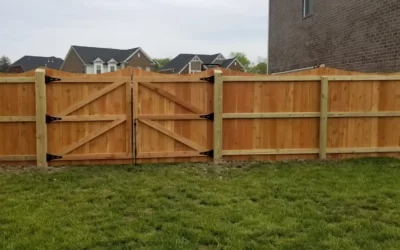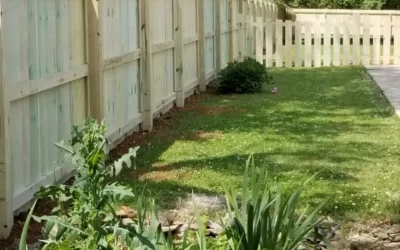When it comes to home improvement, the choices you make typically originate from your own personal tastes and preferences. Sometimes, however, the improvements affect more than just you. Such is the case for installing a new fence around your home. Having a fence can help protect both your property and privacy. But installing or repairing your fence affects not only your home’s curb appeal but your neighbors’ as well. For that reason, practicing good fence etiquette is essential to maintaining good relationships.

Before You Start
Before you build your fence, find out exactly where the boundary lines exist between your home and your neighbors’ homes. Do not rely on your own presumption or your neighbors’ beliefs. If you accidentally build on your neighbor’s property, the municipality could hold them liable for repairs and maintenance. That means that, although the fence is technically yours, your neighbors can decide to change it or tear it down. It’s better to invest the time and money in a surveyor now than to open yourself to a host of problems later.
When installing a fence, a good rule of thumb is to build 1 to 2 feet inside the property line. This firmly establishes that the fence is on your side of the boundary. It also gives you enough space to access the exterior of your fence without invading your neighbor’s property.

Check Local Laws
Laws vary from city to city and state to state, so before erecting a physical and visible boundary between you and your neighbors, make sure you check the local laws. Zoning laws may place some limits on what you can and cannot do with your fencing. For example, if you have a corner lot, you may be restricted on how high you can make your fence to prevent obstructing motorists’ field of vision. To be safe, check with your local zoning office before obtaining permits and starting your fencing project.
Check with Your HOA
If you live in a neighborhood with a homeowner’s association or housing covenant, there are likely a set of guidelines restricting what you can and cannot do with your property. Such agreements are put in place in an effort to preserve home values in that area. Certain design aspects such as the type or style of fence and the stain color could be determined by the homeowner’s association. You may even need permission from the HOA before you can legally install your fence. If you live in such a neighborhood, you should look at your deed carefully before solidifying your fencing plans and starting construction.

Talk to Your Neighbors
If you’re considering installing or replacing a fence on your property, practice good fence etiquette and take some time to talk to your neighbors about the changes you’re wanting to make. Not only is it respectful, but it ensures there aren’t surprises when construction begins. They may find the construction phase a nuisance, especially if they’re caught off guard, causing you additional headaches along the way.
Talking with your neighbors about your plans gives them the chance to express any concerns about the design. After all, in many cases, it’s partially their fence, too. Are they afraid it will be unsightly? Will it block the sunlight to their garden? The time to find out about these concerns is when you’re in the planning phase. There may be adjustments you can make that will allow you to accommodate your neighbors while still meeting your own wishes. If you plan to live in your house for a while and believe your neighbor is likely to do the same, it’s good form to get their input. Getting your neighbors on board now will go a long way towards preventing friction and frustration later.

Good Fences, Good Neighbors
Building a Good Fence
Once you’ve established where the boundary lines lie and you’ve checked in with all the necessary entities to ensure that you’re in the clear, the next step is to begin construction. Aside from measuring to make certain you get the right amount of fencing and hiring a good contractor to install your fence, here are a couple of other things to consider.
Materials
When choosing fencing materials, be careful not to stray too far from the design and look of your home, as well as the other fences in your neighborhood. Wood is the most commonly used material, and for good reason. It’s durable, attractive, and, with a little maintenance, can give your home the sophisticated look it needs. Materials like wrought iron, vinyl, and chain link require less maintenance and upkeep but don’t offer the same level of privacy as wood.
Maintenance
Regardless of which material you choose, all outdoor features need proper maintenance. Always keep in mind that fencing adds to the value of your home, should you ever decide to sell it. Ensuring that your fence is properly taken care of will protect your investment and drastically extend the life of your fence.
Fence Height
If you’re trying to maintain your privacy and keep pets in, the fence around the backyard should be about 6 feet tall. If you’re in an area where deer sightings are common, you may want your fence to be about 8 feet tall. Typically, a fence around the front yard should be no more than 4 feet tall. This allows you to still see what’s going on around you while keeping children and pets in. Fences in the front of homes should also be easy to see through so as to not block drivers’ field of vision.
Finished or Unfinished?
Many fences look the same on both sides. But for instances when this is not the case, it is customary to place the finished or more attractive side where it is visible to the neighborhood. This drastically improves your home’s curb appeal and, in turn, it’s value. If you’re installing fencing between your house and your neighbor’s house, it is the best expression of etiquette to place the finished side facing them and the unfinished side toward you.
When planning and preparing to build a fence, the more you can do on the front end, the better. After all, as Robert Frost once said, “good fences make good neighbors.” Practice good fence etiquette – learn the law, talk to your neighbors, and be as respectful and considerate as possible along the way. By following these helpful tips, you’re well on your way to having the fence you’ve been dreaming of.



